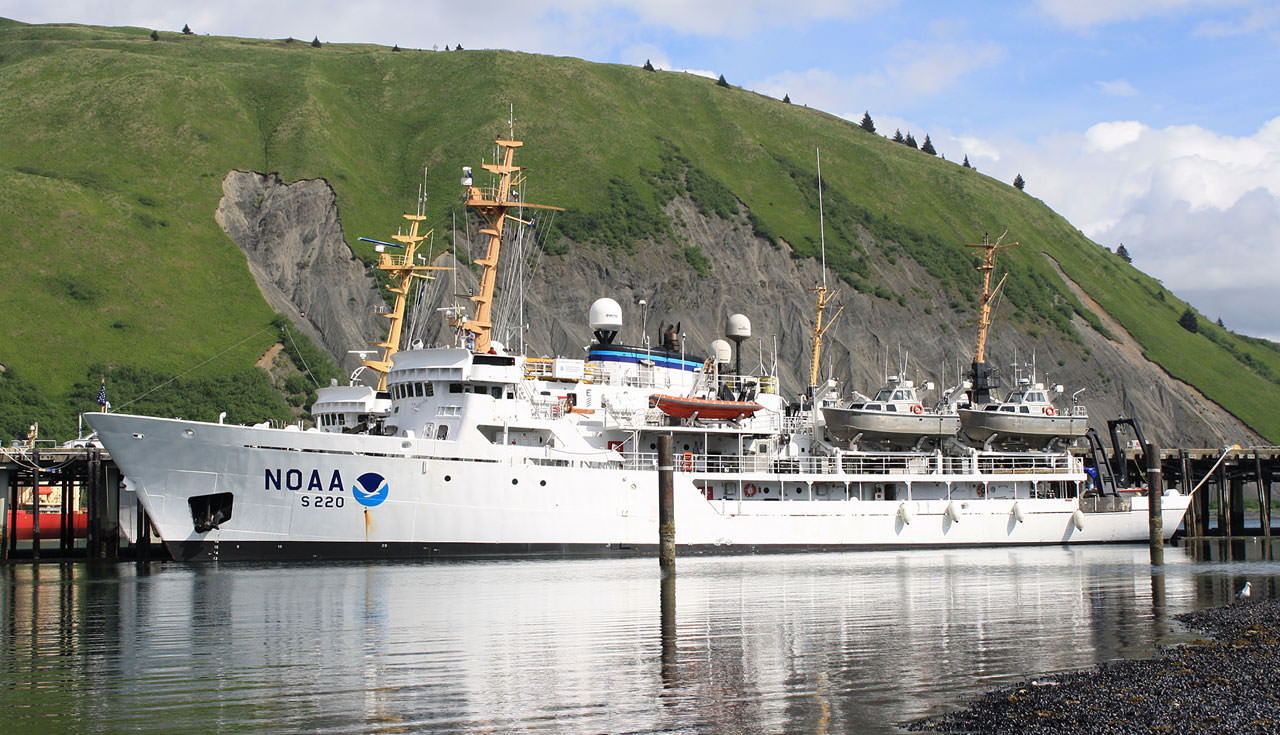NOAA Releases 2017 Hydrographic Survey Season Plans
Annual surveys keep the nation's suite of nautical charts up to date.

Survey Says!
NOAA's Office of Coast Survey annually plans hydrographic survey projects to measure water depths and identify new navigational hazards to keep the nation's suite of nautical charts up to date. Survey planners consider requests from marine pilots, port authorities, the U.S. Coast Guard, the boating community, and others when setting the year's schedule. The NOAA Ship Fairweather, shown here docked in Kodiak, Alaska, is one of four NOAA hydrographic ships.
Coast Survey maintains over a thousand charts and publications covering 95,000 miles of shoreline and 3.4 million square nautical miles of water. Measuring depths and determining new dangers to navigation along U.S. coasts and the Great Lakes is a monumental job because the seafloor is constantly changing due to factors such as storms, erosion, and development.
One of Coast Survey's biggest tasks during the winter months is to plan hydrographic survey projects for the coming field season. Survey planners consider requests from stakeholders such as marine pilots, port authorities, the Coast Guard, and the boating community, and also consider other hydrographic priorities in determining where to survey and when.
This year, Coast Survey has compiled a "living" story map outlining these plans. The story map will be updated as progress is made with each survey project.
2017 planned survey projects
- Approaches to Savannah survey project will update nautical charting products in the approach to the Savannah Outer Harbor Channel, to allow for deeper draft ships and to address concerns about migrating sand shoals.
- Approaches to Jacksonville is in need of updated survey data to meet the needs of larger, fully loaded ships (e.g. NeoPanamax ships) transiting into the Port of Jacksonville.
- Approaches to Houston survey project will address the numerous wrecks and obstructions with their positions reported as approximate on the chart. This poses a danger to navigation particularly for the large traffic volumes in this area of high oil production activity.
- Channel Islands National Marine Sanctuary is a collaborative survey effort among Coast Survey's Integrated Ocean and Coastal Mapping Program, Channel Islands National Marine Sanctuary, and partners. The data from this project will provide seafloor habitat information to support fishery and resource protection mandates and to update nautical charting products within the area.
- Puget Sound needs updated survey data in areas with primary traffic lanes for the large, deep draft vessels transiting to and from the region's busiest ports–Seattle, Tacoma, and Everett.
- West of Prince of Wales Island needs updated survey data to ensure safe navigation for smaller vessels that use the Televak Narrows as an alternate passage during foul weather. These waterways are also economically significant to the coastal delivery of goods to the nearby towns and villages, and important to recreational boaters.
- North Coast of Kodiak Island will have another year of a multi-year surveying campaign in this critical area for increasing fishing and tourism.
- Approaches to Yukon River area has not been surveyed since 1899 and is the most cost effective route to deliver goods to coastal and inland villages of Western Alaska. Although satellite data was used to update the shoreline, the entrances and mouth of the river need to be surveyed to modern standards to provide safe navigation options to vessel traffic.
- Yakutat Bay survey project will update the area adjacent to the famous Hubbard Glacier, a popular cruise ship destination. Updated survey data will benefit Safety of Life at Sea concerns of visiting tour boats and cruise ships, and researchers studying the advancing glacier.
- Lisianski Strait survey project will update this navigationally complex inlet that is heavily trafficked by passenger vessels, smaller tug and tow traffic, and recreational boaters. The current survey vintage dates back to 1917, when data were acquired using lead line instrumentation.
- Tracy Arm is regularly transited during summer months by smaller commercial cruise ships and sightseeing vessels. New survey data will address the hazards that have been reported near the retreating Sawyer Glacier, especially within the uncharted area at the glacier terminus.
- Deer Passage is used by the fishing fleet in Bristol Bay and Bering Sea and by tug and tow traffic delivering goods to the Aleutian Islands, western Alaska, and the Arctic. This project will update survey data from 1911 and 1941.
- Port Clarence survey project will update areas frequently avoided due to unknown depths. This area has also been identified as a major development priority for Alaska and the Arctic region.
Georgia
Florida
Texas
California
Washington
Alaska
NOAA's four hydrographic survey ships—Thomas Jefferson, Ferdinand Hassler, Rainier, and Fairweather—and private survey companies on contract with NOAA begin assigned survey projects in April. The NOAA ships are operated and maintained by the Office of Marine and Aviation Operations, with hydrographic survey projects managed by the Office of Coast Survey.
